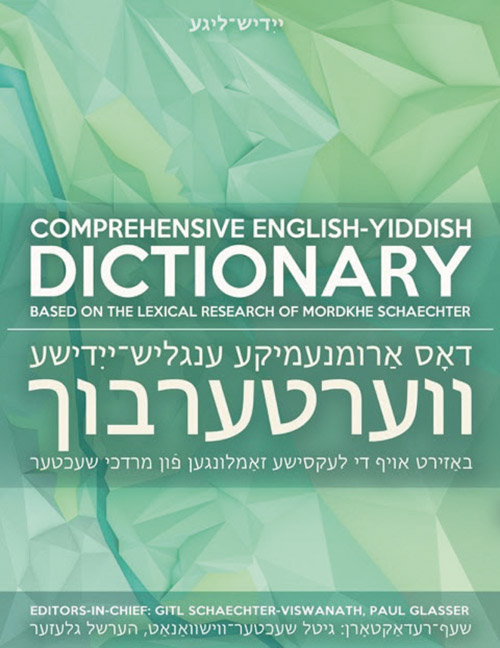
Teaneck resident Gitl Schaechter-Viswanath is helping people answer the question, “Vi volt ir es gezogt of Yiddish?” or “How would you say it in Yiddish?” With the spring 2016 publication of the Comprehensive English-Yiddish Dictionary—the first English-Yiddish Dictionary in nearly 50 years—she has brought the Yiddish language into the 21st century and provided Yiddish equivalents from A to Z for the terminology used in technology, medicine, chemistry, cuisine, agriculture, finance, sports, the military, raising children and many other areas.
Schaechter-Viswanath and co-editor-in-chief Paul Glasser, former Dean of the Max Weinreich Center for Yiddish at YIVO, have compiled this 850-plus-page dictionary, published by Indiana University Press and the League for Yiddish, based on the life work and research of Dr. Mordkhe Schaechter, who was devoted to studying, standardizing and teaching the Yiddish language. For Schaechter-Viswanath, daughter of Dr. Schaechter, the new dictionary marks the conclusion of a 45-year collaboration between father and daughter on a project pursued with both scholarship and passion. Dr. Schaechter passed away in 2007.
“This dictionary will serve as a bridge between 20th-century native Yiddish speakers and 21st-century Yiddish speakers and students thirsting for how to say it in Yiddish.The first of its kind, it includes not only well-established Yiddish words and expressions, but also Yiddish equivalents for much of today’s slang and idiomatic expressions,” explains Schaechter-Viswanath.
Schaechter-Viswanath began collaborating with her illustrious father at the tender age of 12, when he asked her to “work for him—for pay.” Her task was to go through Yiddish newspaper clippings that he had prepared with underlined words and expressions, and record the source of these citations. These became the basis of an archive of index cards, stored in card catalogues and shoeboxes, numbering in the hundreds of thousands and illustrating the wealth of Yiddish words originating from the shtetls and cities of Eastern Europe up to modern times in the Western world. These shoeboxes became the basis for many of the entries in the new Comprehensive English-Yiddish Dictionary; Schaechter-Viswanath then worked for years to significantly expand the scope of this work to include thousands of general words and expressions found in most language dictionaries.
Schaechter-Viswanath and her sisters Rukhl and Eydl and brother Binyumen grew up speaking Yiddish in their Bronx home. Dr. Schaechter, whose passion for Yiddish dated to his boyhood in Romania, dedicated his life to reclaiming Yiddish as a living language for the descendants of its first speakers, the Ashkenazic Jews of Central and Eastern Europe. After earning a doctorate at the University of Vienna and then emigrating to New York, his credentials over the course of a prolific career included serving as a Yiddish professor at Columbia University, the Jewish Theological Seminary of America, The Jewish Teachers Seminary-Herzliah and Yeshiva University. He was an archival researcher for YIVO for many years and editor of Yidishe Shprakh, a journal dedicated to the pronunciation, grammar and vocabulary of standard Yiddish. He founded a worldwide organization Yugntruf, or “Call to Youth,” devoted to encouraging young people to speak Yiddish. He is the author of six books, all in Yiddish.
Against this background, it is no wonder that Schaechter-Viswanath and her siblings were imbued with a life devoted to Yiddish language and culture. Schaechter-Viswanath can recall Shabbat outings to the park when the challenge was to identify everything in Yiddish. She also recalls vividly the “fines” (putting a penny into a pushke) the children were required to pay if they lapsed into English during home conversations.
In her own home, Schaechter-Viswanath and husband Dr. Meylekh (PV) Viswanath, professor of finance at Pace University, raised their children to speak Yiddish and Tamil, respectively, and continue to conduct everyday business with their children in these languages. The children all speak Yiddish and Tamil fluently, and are also fluent in Hebrew. Meena and husband Jamie Conway speak Yiddish to their baby Psakhye Eliezer; Arun will maintain Yiddish in the new home he has just established with his wife, Tali Adler and Mallika, a student at Princeton, also hopes to speak to her children in Yiddish. To date, all of Dr. Schaechter’s 16 grandchildren are fluent in Yiddish, the fruition of his dream.
Schaechter-Viswanath is a woman of multiple talents and accomplishments. While growing up in the Bronx, she attended the Sholem Aleichem Folkshul 21, United Mittleshul and Jewish Teachers Seminary where she graduated with a degree in Jewish Literature. She has also earned degrees in Russian from Barnard College, Nursing from Columbia University and Health Administration from New York University. She has been active in the Yiddish movement her entire life and since 2005 has been Yiddish-language editor of Afn Shvel, the periodical of the League for Yiddish. She is also the author of a book of her Yiddish poetry (with English translation) entitled Plutsemdiker Regn/Sudden Rain (Israel Books, Tel Aviv, 2003).
“With the publication of the Comprehensive English-Yiddish Dictionary,” Schaechter-Viswanath attests, “My father’s lifetime goal eventually became mine as well. I truly believe that he was with me all along, leading the way.”
The dictionary is available at leagueforyiddish.org/verterbukh.html.
By Pearl Markovitz













